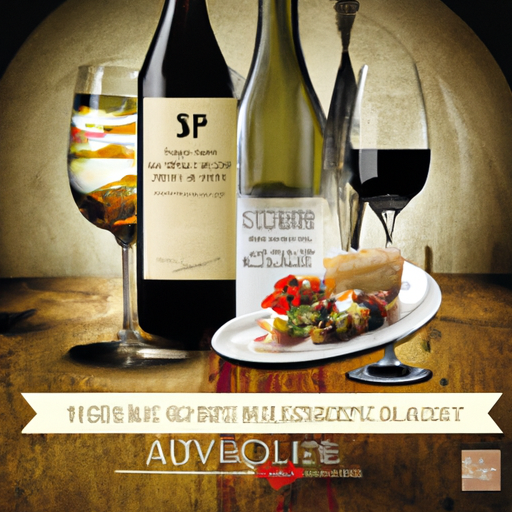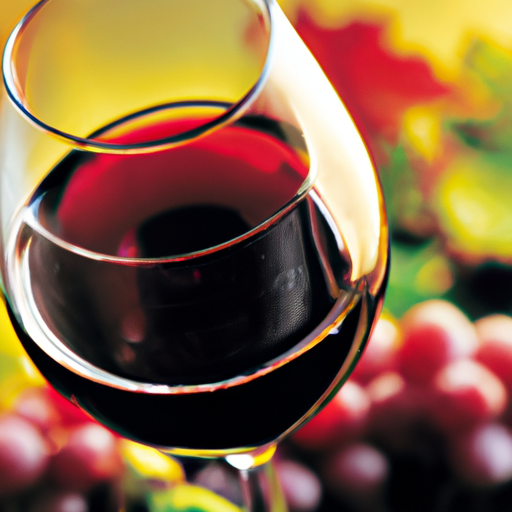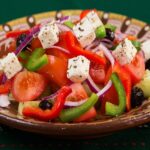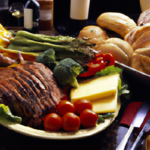Are you a food enthusiast who loves exploring new flavors and experiencing the perfect combination of food and wine? If so, you’re in for a treat! In this article, we’re going to delve into the wonderful world of pairing food and wine, and how you can elevate your dining experience to new heights. So whether you’re a seasoned connoisseur or just starting to discover the joys of pairing, this guide is sure to provide you with valuable insights and tips that will make your taste buds dance with delight.
When it comes to pairing food and wine, the possibilities are endless. The key is to find complementary flavors that enhance each other and create a harmonious experience on your palate. From robust red wines to crisp whites and everything in between, we’ll explore the different types of wines and their ideal food pairings. We’ll also discuss the principles behind food and wine pairing, such as matching intensities, considering textures, and balancing flavors. By the end of this article, you’ll have a deeper understanding of how to create the perfect match for any dish, whether it’s a simple weeknight dinner or a special occasion feast. So sit back, relax, and get ready to embark on a delicious journey into the art of pairing food and wine.
Pairing Food and Wine: A Guide for Food Enthusiasts
Whether you’re hosting a dinner party or simply enjoying a quiet evening at home, the right combination of food and wine can elevate your dining experience to new heights. Pairing food and wine is an art form that requires careful consideration of flavors, textures, and aromas. In this guide, we will explore the basics of food and wine pairing, discuss factors to consider when selecting the perfect combination, and provide tips and tricks for successful pairings. So let’s dive in and embark on a culinary journey of flavors!
The Basics of Food and Wine Pairing
Pairing food and wine is all about creating a harmonious balance between the flavors in your dish and the characteristics of the wine you choose to accompany it. To achieve this balance, it’s important to consider a few key factors:
-
Intensity: The intensity of both the food and the wine should be taken into account. Light dishes are better paired with lighter wines, while robust dishes can handle bolder wines.
-
Flavors: The flavors in the food and the wine should complement each other. For example, a citrusy seafood dish would pair well with a crisp and citrusy white wine.
-
Sweetness: The sweetness in the food should be balanced by the sweetness in the wine. Sweeter wines are best paired with desserts or dishes that have a hint of sweetness.
-
Acidity: The acidity in the food and the wine should be in harmony. High-acid wines can cut through fatty or rich foods, while low-acid wines work well with dishes that have a higher acidity.
Factors to Consider when Pairing Food and Wine
In addition to the basics, there are several other factors to consider when pairing food and wine. These factors can greatly influence the overall dining experience and contribute to a successful pairing.
Pairing Wine with Different Types of Food
Let’s take a closer look at how to pair wine with specific types of food to ensure the best flavor combinations:
Pairing Wine with Appetizers and Starters
Appetizers and starters set the tone for the meal, so it’s important to choose a wine that complements the flavors and textures of these dishes. For light and refreshing appetizers like salads or seafood, consider pairing them with a crisp and citrusy white wine such as Sauvignon Blanc or Pinot Grigio. If you’re serving richer appetizers like pâtés or bruschetta, a medium-bodied red wine like Merlot or Rioja can be a great choice.
Pairing Wine with Seafood and Fish
Seafood and fish dishes can vary greatly in terms of flavor and texture. The key to a successful pairing is to consider the preparation and seasoning of the dish. For delicate and subtly flavored fish like sole or halibut, a light-bodied white wine like Chardonnay or Riesling can enhance the natural flavors without overpowering them. For more robust seafood dishes like grilled salmon or shrimp scampi, a medium-bodied rosé or even a light-bodied red wine like Pinot Noir can provide a delightful contrast.
Pairing Wine with Poultry and White Meat
Poultry and white meat are versatile ingredients that lend themselves well to a wide range of wine pairings. For roasted chicken or turkey, a medium-bodied white wine like Chardonnay or Viognier can provide a nice balance of flavors. If you’re serving a dish with creamy sauces or spices, consider a fuller-bodied white wine like Gewürztraminer or a light-bodied red wine like Gamay. These wines can complement the richness and add depth to the dish.
Pairing Wine with Red Meat and Game
When it comes to pairing wine with red meat and game, the key is to choose a wine with enough structure to match the intensity of the flavors. For classic red meat dishes like steak or lamb, a full-bodied red wine like Cabernet Sauvignon or Syrah can provide the necessary depth and tannins to enhance the meal. For game meats like venison or duck, consider a medium to full-bodied red wine with earthy undertones such as Pinotage or Bordeaux.
Pairing Wine with Vegetarian and Vegan Dishes
Vegetarian and vegan dishes can be just as exciting to pair with wine as their meat-based counterparts. The key is to consider the flavors and textures of the dish. For light and refreshing vegetarian dishes like salads or vegetable stir-fries, a crisp and herbaceous white wine like Sauvignon Blanc or Grüner Veltliner can provide a nice contrast. For heartier dishes like mushroom risotto or roasted root vegetables, a medium-bodied red wine like Sangiovese or Zinfandel can add depth and complexity.
Pairing Wine with Cheese and Charcuterie
Cheese and charcuterie boards are a popular choice for entertaining, and pairing the right wine can take them to the next level. The general rule of thumb is to pair the wine with the strongest flavor of the cheese or charcuterie. For rich and creamy cheeses like Brie or Camembert, a sparkling wine like Champagne or Prosecco can cut through the richness and cleanse the palate. For stronger and more pungent cheeses like blue cheese or aged cheddar, a bold and tannic red wine like Cabernet Sauvignon or Malbec can stand up to the flavors.
Pairing Wine with Desserts and Sweet Treats
Dessert is the perfect way to end a meal, and the right wine pairing can create a memorable experience. When pairing wine with desserts, it’s important to consider the level of sweetness in both the dessert and the wine. For lighter and fruit-based desserts like fruit tarts or sorbets, a sweet white wine like Moscato d’Asti or Sauternes can enhance the flavors. For richer and chocolate-based desserts like chocolate cake or brownies, a fortified wine like Port or Banyuls can provide a delightful contrast.

Exploring Wine Regions and Varietals
To truly understand the art of food and wine pairing, it’s important to explore different wine regions and the varietals they produce. Each region has its own signature pairings that have been developed over centuries of winemaking traditions.
Wine Regions and Their Signature Pairings
Certain wine regions have become famous for their signature pairings. For example, the region of Champagne in France is known for its sparkling wine, which pairs beautifully with oysters and other seafood. The region of Tuscany in Italy is famous for its Chianti and Sangiovese wines, which pair perfectly with tomato-based pasta dishes and grilled meats. Exploring different wine regions and their signature pairings can provide valuable insights into the art of food and wine pairing.
Exploring White Wine Varietals and Their Food Matches
White wine varietals offer a wide range of flavors and can be paired with a variety of dishes. For example, a crisp and mineral-driven Chablis pairs beautifully with oysters, while a aromatic and tropical Sauvignon Blanc can enhance the flavors of grilled vegetables or goat cheese. Exploring different white wine varietals and their food matches can open up a world of possibilities when it comes to pairing food and wine.
Exploring Red Wine Varietals and Their Food Matches
Red wine varietals are often associated with hearty and robust dishes, but they can also be paired with a wide range of flavors. For example, a bold and peppery Shiraz pairs beautifully with a grilled steak, while a smooth and fruit-forward Pinot Noir can complement dishes like roasted salmon or mushroom risotto. Exploring different red wine varietals and their food matches can help expand your knowledge and enhance your food and wine pairing skills.
Enhancing Food and Wine Pairings
While the basics of food and wine pairing are essential, there are several ways to enhance your pairings and create a truly memorable dining experience.
Understanding Flavor Profiles and Complementary Pairings
One way to enhance your food and wine pairings is to understand the flavor profiles of different ingredients and their complementary pairings. For example, a dish with earthy flavors like mushrooms or truffles can be complemented by a wine with earthy undertones like Pinot Noir or Nebbiolo. Similarly, a dish with citrusy flavors like lemon or lime can be enhanced by a wine with citrusy notes like Sauvignon Blanc or Riesling. Understanding the flavor profiles and their complementary pairings can help you create beautifully balanced combinations.
Using Contrasting Pairings to Create Balance
Another way to enhance your pairings is to use contrasting pairings to create balance. For example, pairing a rich and buttery Chardonnay with a tangy and acidic dish can create a delightful contrast of flavors. Similarly, pairing a spicy and bold red wine with a sweet and fruity dessert can create a beautiful balance of flavors. Using contrasting pairings can add depth and complexity to your food and wine combinations.
Experimenting with Unconventional Pairings
While traditional pairings can provide a great starting point, don’t be afraid to think outside the box and experiment with unconventional pairings. Sometimes the most unexpected combinations can create the most exciting flavor experiences. For example, pairing a dry and crisp rosé with spicy Asian cuisine can create a delightful contrast of flavors. Or pairing a rich and full-bodied white wine with a grilled seafood dish can create a harmonious balance. Don’t be afraid to push boundaries and explore new possibilities in your food and wine pairings.
Considering the Impact of Cooking Methods and Sauces on Pairings
When pairing food and wine, it’s important to consider the impact of cooking methods and sauces on the overall flavor profile. Grilled or roasted dishes can develop smoky flavors that can be enhanced by a bold and robust wine. Creamy sauces can add richness and complexity to a dish, which can be balanced by a fuller-bodied wine. Paying attention to the cooking methods and sauces can help you choose the right wine to complement and enhance the flavors.

Tips and Tricks for Successful Food and Wine Pairings
Now that we’ve explored the basics of food and wine pairing and discussed ways to enhance your pairings, let’s dive into some practical tips and tricks for successful pairings.
Taking into Account Seasonality and Local Produce
One way to elevate your pairings is to take into account the seasonality of ingredients and incorporate local produce. Seasonal ingredients often have the best flavor profiles and can create more harmonious pairings. For example, pairing a crisp and citrusy white wine with a fresh summer salad made with locally grown tomatoes and basil can create a truly memorable dining experience. Incorporating local produce not only supports local farmers but also ensures the freshest and most flavorful ingredients for your pairings.
Considering the Occasion and Setting
Pairing food and wine is not just about the flavors, it’s also about the occasion and setting. Consider the mood and atmosphere you want to create and choose pairings that complement the overall experience. For a romantic dinner, a rich and elegant red wine paired with a decadent chocolate dessert can set the stage for a memorable evening. For a casual outdoor gathering, a light and refreshing rosé paired with grilled vegetables or seafood can create a laid-back and enjoyable atmosphere. Consider the occasion and setting to create the perfect food and wine pairings.
Understanding Wine Descriptors and Tasting Notes
Understanding wine descriptors and tasting notes can provide valuable insights into the flavor profile of different wines. When choosing a wine for a specific dish, take the time to read the tasting notes and identify the flavors and aromas that are present in the wine. This can help you determine how well the wine will pair with the flavors of your dish. Look for descriptors like citrus, berry, oak, and earth to guide your selection. Understanding wine descriptors and tasting notes can help you make more informed pairing choices.
Seeking Expert Advice and Recommendations
If you’re new to food and wine pairing or simply want to expand your knowledge, don’t hesitate to seek expert advice and recommendations. Wine professionals, sommeliers, and wine shop owners can provide valuable insights and recommendations based on their expertise. They can guide you through the pairing process, suggest unique combinations, and help you discover new wines and flavors. Seeking expert advice can be a great way to enhance your food and wine pairing skills and discover hidden gems.
Exploring Food and Wine Pairing Experiences
One of the best ways to expand your knowledge and refine your food and wine pairing skills is to immerse yourself in food and wine pairing experiences. Here are a few ideas to get you started:
Attending Wine Tasting Events and Pairing Workshops
Wine tasting events and pairing workshops are a great way to learn more about different wines and their flavor profiles. These events often feature a variety of wines from different regions and offer the opportunity to taste and compare different pairings. Experts and sommeliers are usually present to provide guidance and answer any questions you may have. Attending these events can be both educational and enjoyable, allowing you to explore new flavors and refine your pairing skills.
Visiting Vineyards and Wineries for Interactive Pairing Experiences
Visiting vineyards and wineries provides a unique opportunity to experience food and wine pairings in a picturesque setting. Many vineyards offer tours and tastings that include food pairings specifically designed to complement their wines. These interactive experiences allow you to not only taste the wines but also learn about the winemaking process and the region’s culinary traditions. Immersing yourself in the ambiance and flavors of a vineyard can deepen your appreciation for food and wine pairing.

Pairing Food and Wine for Special Occasions
Food and wine pairings can be particularly important when it comes to special occasions. Here are a few ideas for pairing food and wine for different occasions:
Pairing Food and Wine for Romantic Dinners
For romantic dinners, choosing the right food and wine pairings can help create a sensual and intimate atmosphere. Consider dishes that are known for their aphrodisiac properties, such as oysters or chocolate, and pair them with wines that have a romantic reputation, such as Champagne or a full-bodied red wine. Remember to consider the flavors you and your partner enjoy and create a pairing that reflects your unique tastes and preferences.
Pairing Food and Wine for Holiday Celebrations
Holiday celebrations often involve elaborate meals and festive dishes. When pairing food and wine for holiday celebrations, consider the flavors and traditions associated with the specific holiday. For Thanksgiving, for example, a medium-bodied red wine like Pinot Noir or a fruity and spicy Zinfandel can complement the flavors of roasted turkey and cranberry sauce. For Christmas, a sparkling wine like Prosecco or Champagne can add a touch of elegance and celebration to the meal. Tailor your pairings to the specific holiday and create a memorable dining experience for your guests.
Pairing Food and Wine for Dinner Parties and Gatherings
When hosting dinner parties and gatherings, it’s important to choose food and wine pairings that will please a variety of tastes. Consider offering a selection of wines that can complement a range of dishes and accommodate different preferences. For example, a crisp and refreshing white wine, a medium-bodied red wine, and a sparkling wine can provide options for guests with different taste preferences. Opt for versatile food options like charcuterie boards or tapas-style dishes that can be paired with a variety of wines. Creating a diverse selection of food and wine pairings can ensure that all your guests feel catered to and can enjoy the evening.
Pairing Food and Wine on a Budget
Pairing food and wine doesn’t have to break the bank. With a little creativity, you can create delicious pairings without spending a fortune. Here are a few tips for pairing food and wine on a budget:
Affordable Wine Options for Various Food Pairings
Many affordable wine options offer great value for money and can be paired with a variety of dishes. Look for wines from lesser-known regions or varietals that may not carry the same prestige as more well-known wines but still offer excellent quality. For white wine, consider options like Spanish Albariño or Argentine Torrontés. For red wine, look for varietals like Chilean Carménère or Portuguese Touriga Nacional. These budget-friendly options can provide delightful pairings without breaking the bank.
Maximizing Flavor with Inexpensive Ingredients
Pairing food and wine on a budget doesn’t mean sacrificing flavor. By focusing on maximizing the flavors in your ingredients, you can create delicious pairings without spending a fortune. Choose fruits and vegetables that are in season and at their peak flavor. Experiment with herbs, spices, and homemade marinades to add depth and complexity to your dishes. By maximizing the flavor of your ingredients, you can create pairings that are both budget-friendly and tasty.
The Art of Presentation: Plating and Serving Food and Wine
Pairing food and wine is not just about the flavors, it’s also about the visual appeal and presentation. Taking the time to carefully plate and serve your food and wine can enhance the overall dining experience. Here are a few tips for presentation:
Enhancing the Visual Appeal of Food and Wine Pairings
When plating your dishes, consider using contrasting colors and textures to create visual appeal. Arrange the food in an artistic and eye-catching manner. Use garnishes like fresh herbs, edible flowers, or a sprinkle of spices to add an extra pop of color. Similarly, when serving wine, use beautiful glassware and take care to pour the wine with precision. Paying attention to the visual appeal of your food and wine pairings can elevate the dining experience and make it more enjoyable.
Understanding Glassware and Proper Wine Service
Choosing the right glassware for your wine can greatly enhance the flavors and aromas. For white wine, opt for a glass with a slightly narrower rim to concentrate the aromas. For red wine, choose a glass with a wider bowl to allow the wine to breathe and reveal its full potential. Additionally, understanding proper wine service, including serving temperatures and decanting, can further enhance the flavors of your wine. Taking the time to serve the wine correctly can showcase its qualities and create a more refined dining experience.
Conclusion
Pairing food and wine is a delightful journey that can enhance your dining experiences and create memorable moments. By understanding the basics of food and wine pairing, considering factors like flavors and intensity, and exploring different wine regions and varietals, you can unlock a world of flavor combinations. Enhancing your pairings through flavor profiles, contrasting combinations, and experimentation can take your pairings to the next level. And by considering tips and tricks, seeking expert advice, and immersing yourself in food and wine pairing experiences, you can refine your skills and discover new favorites. So, grab a glass, savor the flavors, and enjoy the art of pairing food and wine!



